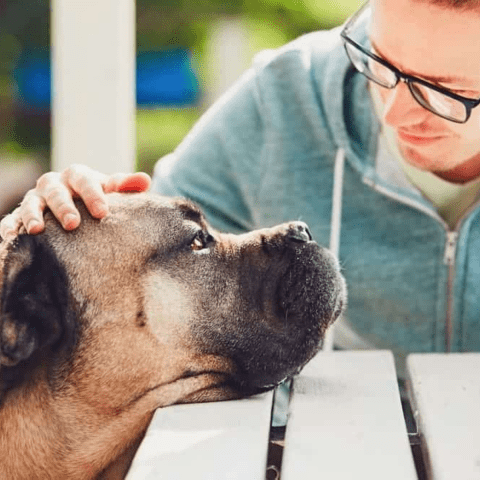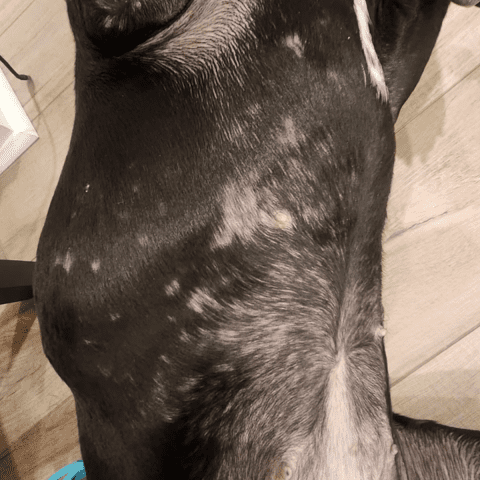You’ve probably experienced the frustration of watching your Cane Corso, Max, scratch and chew relentlessly, only to be left with a puzzled expression and a myriad of unanswered questions. Take the case of Bella, a three-year-old Cane Corso who developed severe skin irritation and hair loss after her owner introduced a new brand of dog food. As you navigate the complex world of allergies in Cane Corsos, you’ll need to identify and address the root causes of these reactions. But where do you start, and what are the most common triggers you should be on the lookout for?
Recognizing Common Allergy Symptoms

When your Cane Corso exhibits unusual behaviors or physical changes, prompt identification of potential allergy symptoms is essential in preventing further discomfort and potential health complications. As a responsible owner, it’s imperative to recognize common allergy symptoms to provide timely interventions. Be aware of changes in your dog’s behavior, such as excessive scratching, chewing, or licking, which can indicate skin allergies. Other signs may include redness, inflammation, or hair loss. Respiratory issues, like sneezing, coughing, or wheezing, can also be indicative of allergies.
To identify allergy patterns, maintain a symptom diary to track your dog’s reactions. Record the date, time, and severity of symptoms, as well as any potential triggers. This detailed record will help you and your veterinarian identify patterns and correlations. By monitoring your Cane Corso’s symptoms and potential triggers, you can work together to develop an effective management plan. Remember, early detection and intervention can greatly improve your dog’s quality of life.
Identifying Food Allergy Triggers
Identifying the specific ingredients in your Cane Corso’s diet that trigger allergic reactions is essential to alleviating discomfort and preventing long-term health issues. As an owner, it’s vital to pinpoint the culprits behind your dog’s allergic responses. One effective way to do this is by maintaining a food diary. Record every meal, snack, and treat you give your Cane Corso, along with any symptoms that arise. This will help you identify patterns and potential correlations between certain foods and reactions.
Another strategy is ingredient rotation. This involves switching your dog’s food to a novel protein source, such as venison or fish, and monitoring their response. If symptoms subside, it may indicate an allergy to a specific ingredient in their previous diet. Be sure to work with your veterinarian to rule out other potential causes and develop a customized plan for your Cane Corso. By methodically identifying and eliminating trigger ingredients, you can create a tailored diet that promotes your dog’s overall health and well-being.
Environmental Allergens to Watch
As you explore environmental allergens that affect your Cane Corso, you’ll want to focus on three key areas. First, you’ll need to examine airborne allergens like pollen and dust mites, which can exacerbate respiratory issues. Additionally, you’ll need to address potential allergens like mold and fungi growth, as well as insect bites and stings, which can cause skin irritation and other reactions.
Pollen and Dust Mites
You’ll likely find that pollen and dust mites are two of the most common environmental allergens affecting your Cane Corso. As a responsible owner, you must understand the impact of these allergens on your dog’s health.
Pollen is a significant culprit, especially during pollen seasons. Trees, grasses, and weeds release pollen into the air, triggering allergic reactions in sensitive dogs. If your Cane Corso is allergic to pollen, you may notice symptoms like itching, scratching, and skin irritation during peak pollen seasons.
Dust mites, on the other hand, thrive in humid environments and are often found in carpets, upholstered furniture, and bedding. These microscopic creatures feed on human and animal dander, producing waste that becomes airborne and exacerbates allergies. Mite habitats, such as dusty areas and fabric, can harbor these allergens, making it vital to maintain a clean and dust-free environment for your dog.
As a responsible owner, you must take steps to minimize your dog’s exposure to these allergens.
Mold and Fungi Growth
Mold and fungi growth thrive in damp, humid environments, especially in areas with poor ventilation, and can trigger severe allergic reactions in sensitive dogs like your Cane Corso. As a responsible pet owner, it’s crucial to identify and manage these environmental allergens to guarantee your dog’s comfort and well-being.
| Mold and Fungi Sources | Prevention Strategies |
|---|---|
| Damp basements or crawl spaces | Guarantee good ventilation, use dehumidifiers, and fix water leaks |
| Wet or flooded areas | Dry the area quickly, use fans, and remove standing water |
| Poorly ventilated areas | Improve air circulation, use exhaust fans, and open windows |
| Decaying organic matter | Regularly clean and disinfect surfaces, remove rotting materials |
To minimize mold and fungi growth, keep an eye out for musty odors, dampness, and water damage in your home. Regularly inspect your home, especially areas prone to moisture accumulation, and take prompt action to address any issues. By being proactive, you can reduce the risk of mold and fungi growth and create a healthier environment for your Cane Corso.
Insect Bites and Stings
During the warmer months, insect bites and stings become a significant concern, as they can cause severe allergic reactions in sensitive breeds like Cane Corsos. As a Cane Corso owner, being aware of the potential threats that insects can pose to your pet’s health is vital.
Some common culprits to watch out for:
- Mosquitoes: Their bites can cause intense itching, leading to skin irritation and potential infections.
- Bees and Wasps: Their venom can trigger severe allergic reactions, including anaphylaxis, which can be life-threatening.
- Fleas: Their bites can cause intense itchiness, leading to scratching and skin irritation.
- Ticks: Their bites can transmit diseases like Lyme disease and ehrlichiosis, which can be devastating for your pet’s health.
If your Cane Corso is bitten or stung, providing immediate itch relief and monitoring their behavior closely is vital. In severe cases, bee venom can cause anaphylaxis, which requires prompt veterinary attention. By being proactive and taking preventative measures, you can help minimize the risk of insect bites and stings and keep your Cane Corso safe and healthy.
Diagnosing Skin Allergies in Cane Corsos

When diagnosing skin allergies in your Cane Corso, you’ll want to start with a thorough visual examination to identify common signs of skin allergies, such as redness, itching, and hair loss. Your veterinarian will likely use a combination of visual examination methods, including inspecting the affected areas and looking for signs of secondary infections. Next, they may perform skin scraping tests to collect skin cells and debris for further analysis.
Visual Examination Methods
You can identify skin allergies in your Cane Corso through a combination of visual examination methods, including inspecting the skin and coat, observing behavioral changes, and evaluating the dog’s overall health. A thorough examination can help you pinpoint potential allergy triggers and inform further diagnostic testing.
During a visual examination, look for the following signs of skin allergies:
- Coat changes: Dull, brittle, or thinning coat, especially around the ears, paws, and belly.
- Lesions and hot spots: Red, itchy, or inflamed areas on the skin, which can lead to secondary infections.
- Skin thickening: Areas of thickened skin, especially on the ears, paws, or belly.
- Excessive shedding: Excessive hair loss, particularly during seasonal changes.
Skin Scraping Tests
Skin scraping tests, a diagnostic tool used to identify skin allergies in Cane Corsos, involve collecting skin cells and debris for microscopic examination to detect potential allergens. As you work with your veterinarian to diagnose your dog’s skin allergy, you’ll likely undergo a skin scraping test. This involves gently scraping the affected skin area to collect cells and debris from the skin’s surface and upper layers. The collected sample is then examined under a microscope to identify potential allergens, such as mites, fleas, or bacteria.
The test’s reliability depends on the quality of the sample and the expertise of the veterinarian performing the test. A well-collected sample from the affected skin area can provide valuable insights into the underlying cause of your Cane Corso’s skin issues. By examining the skin layers and debris, your veterinarian can identify potential allergens and develop an effective treatment plan. With accurate diagnosis and targeted treatment, you can help your Cane Corso find relief from skin allergies and enjoy a healthier, happier life.
Effective Allergy Treatment Options
Cane Corsos suffering from allergies can find relief with a range of effective treatment options, including pharmacological interventions, dietary changes, and environmental adjustments tailored to their specific needs. You, as a responsible owner, can explore the following treatment options to alleviate your dog’s allergy symptoms:
- Medications: Antihistamines, corticosteroids, and cyclosporine can help reduce itching, inflammation, and other allergic reactions.
- Immunotherapy: This long-term treatment involves regular injections or sublingual tablets to desensitize your Cane Corso to specific allergens, providing long-term benefits.
- Natural remedies: Adding Omega-3 fatty acids, probiotics, and antioxidants to your dog’s diet can help soothe and calm the skin, reducing inflammation and promoting overall health.
- Dietary changes: Identifying and eliminating specific food allergens or sensitivities can notably reduce allergic reactions in your Cane Corso.
Preventing Future Allergic Reactions
To minimize the recurrence of allergic reactions in your dog, pinpointing and avoiding the specific allergens that trigger the reactions is essential. By doing so, you’ll reduce the likelihood of future reactions and alleviate your dog’s discomfort. A healthy diet plays a significant role in strengthening your Cane Corso’s immune system, making it more resilient to allergens. Feed your dog a well-balanced, nutrient-rich diet that includes essential fatty acids, vitamins, and minerals. This will help regulate their immune response and reduce inflammation. Additionally, consider adding omega-3 supplements to their diet, as they have anti-inflammatory properties that can benefit your dog’s overall health. By maintaining a healthy diet and avoiding allergens, you’ll create a strong foundation for your dog’s immune system, reducing the risk of future allergic reactions. Regular veterinary check-ups will also help monitor your dog’s health and catch any potential issues early on.
Frequently Asked Questions
Can Cane Corsos Develop Allergies at Any Age or Is It Limited to Puppies?
As you wonder about your Cane Corso’s allergy development, know that they can occur at any age, but sensitivity periods during puppy development (0-12 months) and breed characteristics can increase the risk, especially as their immune system matures.
Are Allergies in Cane Corsos More Common in Certain Bloodlines or Breeding Lines?
As you explore the world of Cane Corsos, you’ll discover that allergies can lurk in certain breeding lines, fueled by genetic predisposition and questionable breeding practices, making some bloodlines more prone to allergic reactions.
Can Allergies in Cane Corsos Be Inherited From Their Parents or Grandparents?
You’re wondering if your Cane Corso’s allergies can be inherited from their parents or grandparents. Research suggests a genetic link, and a family history of allergies can increase the risk of your dog developing them.
Do Cane Corsos With Allergies Have a Higher Risk of Other Health Issues?
As you care for your Cane Corso, you’ll notice that allergies can increase the risk of other health issues, particularly if immune dysfunction and genetic predisposition are underlying factors, making vigilant monitoring essential.
Can Cane Corsos Outgrow Their Allergies or Are They Lifelong Conditions?
As you navigate the complex journey of your Cane Corso’s allergies, imagine a delicate balance between their immune system and genetic predisposition. While it’s possible for some allergies to fade, others may persist, making lifelong management a vital part of their care.
Conclusion
As you take control of your Cane Corso’s allergy management, remember that every small step forward is a victory. By recognizing symptoms, identifying triggers, and implementing effective treatments, you’re not just alleviating discomfort – you’re giving your furry friend a second chance at a life free from the constant itch and scratch. Like a ray of sunshine breaking through the clouds, a well-managed allergy plan can bring hope and relief to your beloved pet.
